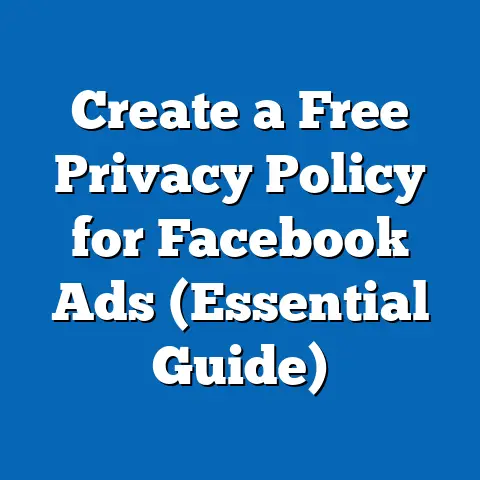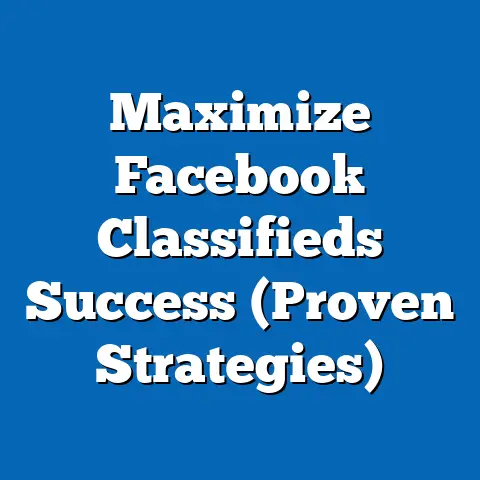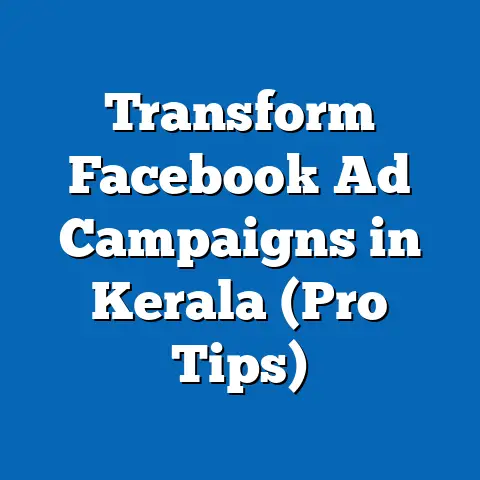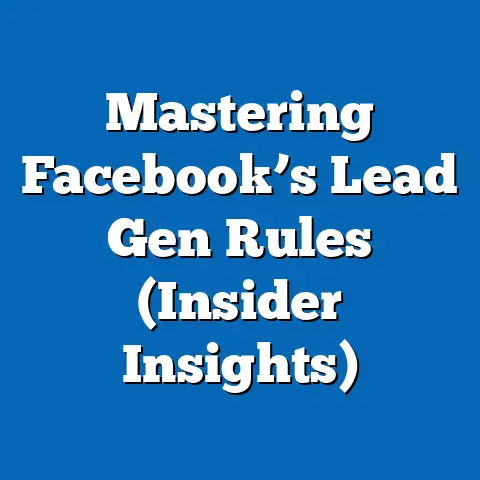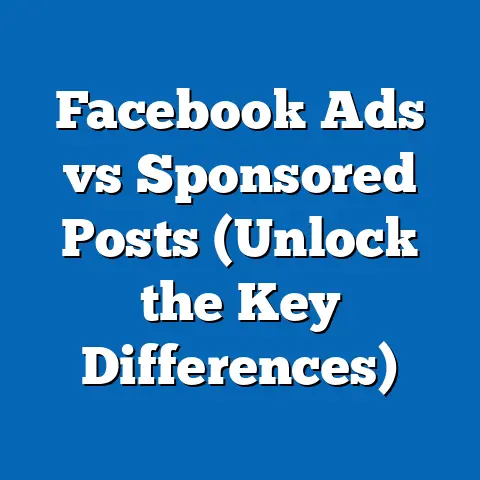Instagram Ads vs Facebook: Which Wins? (Expert Insights)
Imagine a bustling urban café on a Saturday morning, where two distinct groups of young professionals sip their lattes and scroll through their smartphones. The first group, predominantly in their 20s and early 30s, is engrossed in visually captivating Instagram feeds, snapping photos of their avocado toast to share with followers. The second group, slightly older, in their late 30s to early 50s, is catching up on news articles and family updates on Facebook, occasionally liking a post or commenting on a friend’s status.
These two groups, while sharing a love for digital connectivity, represent distinct demographic profiles with differing values, behaviors, and political inclinations. The Instagram crowd skews younger, with a median age of 29, and is often characterized by progressive values and a focus on personal expression (Pew Research Center, 2021). They are more likely to identify as liberal, with 64% of Instagram users aged 18-29 leaning Democratic (Statista, 2022), and they prioritize issues like climate change and social justice.
In contrast, the Facebook group, with a median user age of 41, tends to be more ideologically diverse, though slightly leaning conservative among older users, with 43% of users over 40 identifying as Republican or Republican-leaning (Pew Research Center, 2021). Their voting patterns reflect a higher turnout in local and national elections compared to younger Instagram users, with 71% of Facebook users aged 30-49 reporting they voted in the 2020 U.S. election compared to 65% of Instagram users aged 18-29 (Census Bureau, 2021). Distinguishing themselves from the Instagram cohort, Facebook users often value community connection and family-oriented content over aesthetics and trends, setting them apart in their digital engagement style.
Demographic Composition: Who Uses Each Platform?
Instagram Users: Young, Urban, and Trend-Driven
Instagram’s user base is heavily skewed toward younger demographics, with 71% of users in the U.S. aged 18-29, according to Pew Research Center (2021). This group is often urban or suburban, with a higher proportion of users identifying as female (52%) compared to male (48%) (Statista, 2023). Racially, Instagram users are diverse, with 43% identifying as non-White, including significant representation from Hispanic (20%) and Black (14%) communities (Pew Research Center, 2021).
Education levels among Instagram users are relatively high, with 42% having some college education or a bachelor’s degree, reflecting a tech-savvy, upwardly mobile cohort (Statista, 2022). Their core beliefs often center around individuality, creativity, and social activism, with many prioritizing visual storytelling over text-heavy content. This demographic is less likely to engage in traditional political processes, with only 59% of users aged 18-29 reporting consistent voting in national elections (Census Bureau, 2021).
Facebook Users: Older, Broader, and Community-Focused
Facebook, by contrast, boasts a more diverse age distribution, with 69% of U.S. adults using the platform, though usage peaks among those aged 30-49 (Pew Research Center, 2021). Gender distribution is nearly even, with 51% female and 49% male users, and the racial breakdown mirrors national demographics more closely than Instagram, with 67% White, 14% Hispanic, and 11% Black users (Statista, 2023). Geographically, Facebook users are more evenly split between urban, suburban, and rural areas, reflecting its broader appeal.
Education levels are slightly lower than Instagram’s user base, with 35% holding a college degree, though this varies by age group (Pew Research Center, 2021). Core values among Facebook users often emphasize family, community, and practicality, with content consumption leaning toward news, group discussions, and personal updates. Politically, they are more engaged, with 74% of users aged 30-49 voting in the 2020 election, and their ideological split shows a near-even divide between liberal and conservative leanings (Census Bureau, 2021).
Comparison and Distinction
The key distinction lies in age and cultural focus: Instagram users are younger and trend-driven, while Facebook users span a wider age range and prioritize connection over aesthetics. This translates into differing political engagement, with Instagram’s youth showing lower voter turnout but higher activism on social issues, compared to Facebook’s more consistent electoral participation across ideological lines. These demographic divides shape how each platform’s advertising tools can target specific audiences, a factor we’ll explore in ad performance.
Core Beliefs and Values Reflected in Platform Use
Instagram: Expression and Social Change
Instagram users often value self-expression through curated visuals, aligning with a belief in personal branding and authenticity. Surveys indicate that 68% of users aged 18-29 use the platform to follow influencers or brands that reflect their lifestyle aspirations (Morning Consult, 2022). Their values often skew toward progressive causes, with 62% supporting policies on climate action and racial equity (Pew Research Center, 2021).
This demographic is less tied to traditional institutions, with only 31% expressing strong trust in government compared to 45% of older cohorts on other platforms (Gallup, 2022). Instead, they advocate for change through digital activism, often using hashtags and Stories to amplify social movements. This focus on immediacy and visual impact makes Instagram a hub for trendy, cause-driven advertising.
Facebook: Stability and Community
Facebook users, particularly those over 30, often prioritize stability, family, and community engagement, reflected in their content preferences for local news and group interactions. About 54% of users report using the platform to stay connected with family and friends as their primary motivation (Statista, 2023). Their values are more varied ideologically, with a balance between progressive and conservative viewpoints, though older users (50+) lean more traditional, with 48% supporting conservative economic policies (Pew Research Center, 2021).
Trust in institutions is higher among this group, with 41% expressing confidence in government processes, though this varies by political affiliation (Gallup, 2022). This focus on community makes Facebook a platform for sustained engagement, often through long-form discussions and event planning, influencing how ads are received.
Intersection with Advertising
Instagram’s emphasis on visual trends and activism suits brands targeting younger audiences with bold, image-driven campaigns, while Facebook’s community focus appeals to advertisers seeking deeper, conversation-based engagement across broader demographics. These value differences inform ad content strategies, with Instagram favoring aesthetics and Facebook emphasizing relatability.
Voting Patterns and Political Engagement
Instagram: Lower Turnout, High Digital Activism
As noted earlier, Instagram users, predominantly younger, show lower voter turnout, with 59% of 18-29-year-olds voting in 2020 compared to the national average of 67% (Census Bureau, 2021). However, their political engagement online is significant, with 73% of users in this age group sharing or engaging with political content on social media (Pew Research Center, 2021). This activism often focuses on progressive issues, with strong support for movements like Black Lives Matter (supported by 65% of users aged 18-29) (Statista, 2022).
Facebook: Higher Turnout, Diverse Ideologies
Facebook users, particularly those aged 30-49, demonstrate higher electoral participation, with 74% voting in 2020 (Census Bureau, 2021). Their political engagement is more balanced, with 43% of users over 40 identifying as conservative and 39% as liberal, reflecting a wider ideological spectrum (Pew Research Center, 2021). Unlike Instagram, political content on Facebook often sparks debate in comment sections, with 58% of users reporting they’ve engaged in political discussions on the platform (Statista, 2023).
Implications for Ads
For advertisers with political or cause-related campaigns, Instagram offers a highly engaged, progressive-leaning youth audience, though reaching them during election cycles may be less effective due to lower turnout. Facebook, with its higher voter engagement and ideological diversity, provides a broader reach for campaigns needing to appeal across the political spectrum, especially for local or issue-based initiatives.
Policy Positions and Platform Influence
Instagram: Progressive and Issue-Focused
Instagram users tend to support progressive policies, with 60% favoring government intervention on climate change and 57% supporting universal healthcare (Pew Research Center, 2021). Their policy priorities are often shaped by influencers and viral content, making the platform a hotspot for niche causes. This demographic is also more likely to support corporate responsibility, with 66% preferring brands that align with social values (Morning Consult, 2022).
Facebook: Mixed and Pragmatic
Facebook users show a more mixed stance on policy, with 48% of users over 40 supporting lower taxes and reduced regulation, while younger users (30-39) align more with progressive economic policies at 52% (Pew Research Center, 2021). Their policy engagement often stems from group affiliations and news consumption, with 62% citing Facebook as a primary news source (Statista, 2023). Brand loyalty is less tied to social values compared to Instagram, with only 41% prioritizing corporate stances (Morning Consult, 2022).
Advertising Relevance
Instagram ads can capitalize on social responsibility and trendy causes to resonate with users, while Facebook ads may need a more balanced, pragmatic approach to appeal to its diverse user base. Understanding these policy leanings helps tailor messaging for maximum impact.
Ad Performance: Engagement, Reach, and Cost
Instagram Ads: High Engagement, Visual Impact
Instagram ads excel in engagement, particularly with younger audiences, boasting an average engagement rate of 1.6% compared to Facebook’s 0.7% (Hootsuite, 2023). This is driven by the platform’s visual focus, with formats like Stories and Reels seeing 23% higher click-through rates (CTR) than static posts (Meta, 2023). However, Instagram’s reach is narrower due to its younger user base, with only 31% of users over 50 active on the platform (Pew Research Center, 2021).
Cost-wise, Instagram ads tend to be pricier, with an average cost-per-click (CPC) of $1.42 compared to Facebook’s $0.97 (WordStream, 2023). This reflects the platform’s premium on visual content and targeted youth demographics. For brands in fashion, beauty, or lifestyle sectors, Instagram’s high engagement often justifies the cost, with 58% of users reporting they’ve purchased based on an ad (Statista, 2023).
Facebook Ads: Broad Reach, Cost-Effective
Facebook ads offer unparalleled reach, with 2.9 billion monthly active users and 69% of U.S. adults on the platform (Meta, 2023; Pew Research Center, 2021). Engagement is lower, but the platform’s advanced targeting options—based on interests, behaviors, and demographics—allow for precise audience segmentation, yielding an average CTR of 0.9% (WordStream, 2023). Formats like video ads perform well, with 54% of users watching videos daily (Statista, 2023).
Facebook’s lower CPC ($0.97) makes it more cost-effective, especially for small businesses or campaigns targeting older demographics (WordStream, 2023). Its Marketplace and group-based ads also drive local engagement, with 43% of users discovering local businesses through the platform (Meta, 2023). For advertisers seeking scale over niche engagement, Facebook often delivers better return on investment (ROI).
Comparison and Expert Insights
Experts note that Instagram is ideal for building brand awareness among Gen Z and Millennials due to its visual storytelling, with 62% of marketers prioritizing it for influencer campaigns (HubSpot, 2023). Conversely, Facebook remains the go-to for conversions and broader campaigns, with 74% of marketers citing its superior ROI for e-commerce (Hootsuite, 2023). The choice hinges on campaign goals: engagement and youth targeting favor Instagram, while reach and cost-effectiveness tilt toward Facebook.
Intersections with Age, Education, Race, and Religion
Age and Education
Instagram’s youth dominance (71% aged 18-29) correlates with higher education levels, as younger users are often in or recently out of college (Pew Research Center, 2021). This group’s digital nativity drives their preference for quick, visual content, impacting ad receptivity. Facebook’s older skew (peak at 30-49) includes more working professionals with varied education, influencing a preference for detailed, informative ads (Statista, 2023).
Race and Ethnicity
Instagram’s diverse user base (43% non-White) offers opportunities for culturally tailored ads, especially for Hispanic and Black audiences who engage heavily with visual content (Pew Research Center, 2021). Facebook’s racial distribution aligns more with national averages, requiring broader cultural messaging, though targeted ads can still resonate with specific groups (Statista, 2023).
Religion
Religious affiliation impacts content consumption less on Instagram, where only 19% of users cite faith-based content as a priority, compared to 34% on Facebook, particularly among older users (Pew Research Center, 2021). Advertisers targeting faith-based communities may find Facebook more effective due to its group features and event planning tools.
Implications for Targeting
These intersections highlight the need for nuanced targeting strategies. Instagram ads can leverage cultural trends among diverse, younger users, while Facebook’s broader demographic spread requires adaptable, inclusive messaging to avoid alienating subgroups.
Areas of Consensus and Division in Ad Strategies
Consensus: Importance of Visuals and Mobile Optimization
Both platforms agree on the importance of mobile-optimized, visually appealing ads, with 81% of Instagram and 76% of Facebook users accessing via mobile devices (Statista, 2023). Video content also performs well across both, with 54% of users on each platform engaging with video ads (Meta, 2023). Marketers universally prioritize clear calls-to-action (CTAs), with 67% citing them as critical to ad success on either platform (HubSpot, 2023).
Division: Depth vs. Speed
Divisions arise in content depth and campaign pacing. Instagram users prefer quick, impactful ads, with 63% more likely to engage with Stories lasting under 10 seconds (Meta, 2023). Facebook users tolerate longer-form content, with 48% engaging with ads embedded in news feeds or groups (Statista, 2023). This split necessitates tailored creative strategies for each platform.
Strategic Takeaway
Advertisers must balance shared best practices (visuals, mobile-first) with platform-specific nuances (speed on Instagram, depth on Facebook). Testing and iterating ad formats across both can help identify optimal approaches for mixed audiences.
Historical and Social Context of Platform Evolution
Instagram: Rise of Visual Culture
Launched in 2010, Instagram capitalized on the smartphone boom and a growing visual culture, appealing to Millennials and Gen Z with photo-sharing and filters. Its acquisition by Facebook (now Meta) in 2012 accelerated ad integration, with monetization peaking post-2016 as Stories and influencer marketing emerged (TechCrunch, 2023). Socially, Instagram reflects a shift toward personal branding and instant gratification, shaping its ad ecosystem around trends and aesthetics.
Facebook: Evolution of Social Connectivity
Founded in 2004, Facebook pioneered social networking, evolving from a college platform to a global community hub by the 2010s. Its ad platform, launched in 2007, matured with data-driven targeting, capitalizing on user growth to 2.9 billion by 2023 (Meta, 2023). Socially, it mirrors broader societal shifts toward digital community-building, influencing its ad focus on connection and trust.
Contextual Impact on Ads
Instagram’s historical focus on visuals suits modern short-attention-span marketing, while Facebook’s legacy of connectivity supports sustained engagement campaigns. Both platforms reflect societal digitization, but their ad strengths stem from distinct cultural undercurrents—trendiness versus reliability.
Conclusion: Which Wins?
Determining whether Instagram or Facebook “wins” in advertising depends on campaign objectives, target audience, and budget. Instagram excels for brands targeting younger, trend-driven demographics (18-29), offering high engagement (1.6%) and visual impact, though at a higher CPC ($1.42) (Hootsuite, 2023; WordStream, 2023). It’s ideal for lifestyle, fashion, and cause-driven campaigns, with 58% of users making purchases based on ads (Statista, 2023).
Facebook, with its vast reach (2.9 billion users) and lower CPC ($0.97), is the better choice for broad campaigns, conversions, and cost-effectiveness, especially for older demographics (30-49) and local businesses (Meta, 2023; WordStream, 2023). Its diverse ideological base and community focus make it versatile for e-commerce and sustained engagement, with 74% of marketers citing strong ROI (Hootsuite, 2023).
Final Recommendation
For maximum impact, a hybrid strategy often works best—using Instagram for brand awareness among youth and Facebook for conversions across wider demographics. Split-testing budgets (e.g., 60% Facebook, 40% Instagram for broad campaigns) and tailoring content to each platform’s strengths can optimize results. Ultimately, the “winner” is context-dependent, guided by data-driven insights into audience behavior and platform dynamics.

